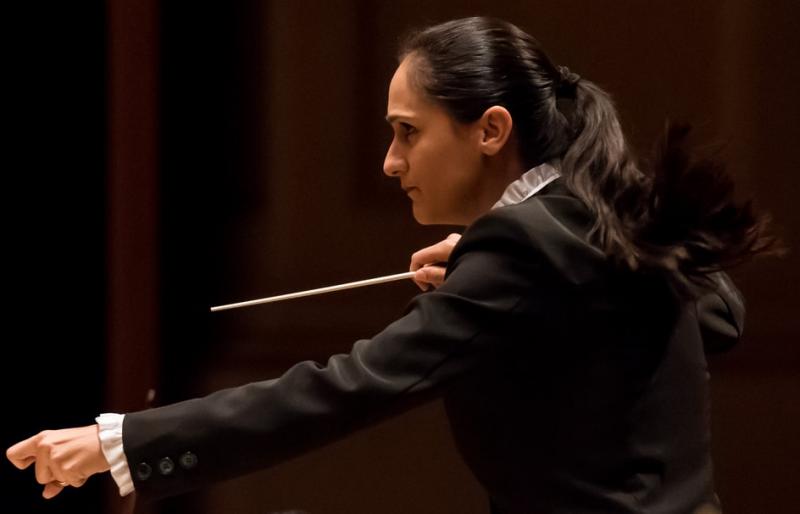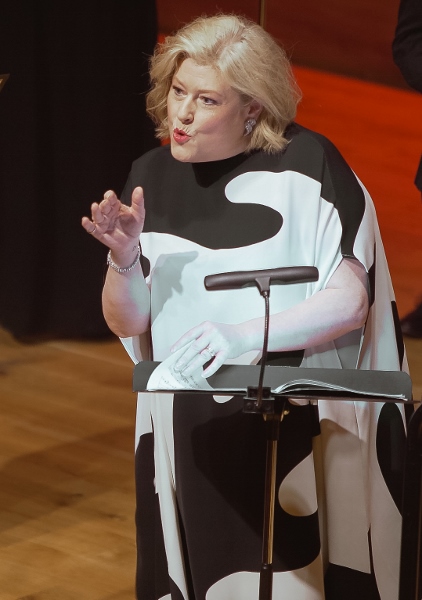Cargill, Kantos Chamber Choir, Manchester Camerata, Menezes, Stoller Hall, Manchester review - imagination and star quality | reviews, news & interviews
Cargill, Kantos Chamber Choir, Manchester Camerata, Menezes, Stoller Hall, Manchester review - imagination and star quality
Cargill, Kantos Chamber Choir, Manchester Camerata, Menezes, Stoller Hall, Manchester review - imagination and star quality
Choral-orchestral collaboration is set for great things

Brazil-born conductor Simone Menezes, known for imaginative and pioneering concert presentation, presided over a striking and illuminating programme shared by Manchester’s Kantos Chamber Choir and Manchester Camerata, with the star quality of Karen Cargill the icing on the cake.
The association between the youthful choir (founded and directed by Ellie Slorach) and orchestra is still relatively new but looks set to lead to great things. In this case there was an intriguing link between several of the pieces on offer and an understated but carefully realised staging: an assembly of unlit candles at the front of the stage, dimmed lighting, some processional movement for the choir – we were invited into a world of memorial and solemnity.
Instead of opening with short pieces in separation, Menezes presented the first three of them in segue: the linking idea of a tolling bell (scored by Arvo Pärt as the opening of his Cantus in Memoriam Benjamin Britten) used first to presage Purcell’s eight-part Hear My Prayer anthem and then Pärt’s Da pacem Domine afterwards. The choir began singing in the gallery above and behind their audience: then moved silently to the main platform as Cantus in Memoriam Benjamin Britten was played, ready for their role in Da pacem Domine.
Their tone quality and tuning are remarkable, exemplifying the best mixed choir singing likely to be heard anywhere, and the Camerata strings, led by Caroline Pether, were a blended, sonorous body capable of a dynamic range from a tiny whisper to a rich tutti.
 That tolling tubular bell was heard again in Britten’s Phaedra, with Karen Cargill (pictured right by Jan Cipriani) the soloist. Officially a “dramatic cantata” for mezzo-soprano and strings plus percussion and harpsichord (with obeisance to the baroque structure of recitative and more free-ranging structure following), it’s been described as a mini-opera in its own right, written near the end of the composer’s life – almost contemporaneous with Death in Venice – and first sung by Janet Baker. There are two themes usually observed in the piece, itself based on Racine’s verse drama – one the idea of illicit love and self-revulsion (and in some ways its cry of “I love you! Fool, I love you, I adore you!”, as the protagonist admits to longing for her husband’s own son, lets right out what Aschenbach holds in), and the other Britten’s own intimations of mortality as its final section describes the approach of death from self-poisoning. Karen Cargill is a great dramatic singer but here I think it was the latter that took prominence. Her peerless tone was used more to express pleading in the former section (it is addressed to the husband, after all), and resolution in the latter. The orchestral role was finely played and skilfully paced and controlled by Menezes.
That tolling tubular bell was heard again in Britten’s Phaedra, with Karen Cargill (pictured right by Jan Cipriani) the soloist. Officially a “dramatic cantata” for mezzo-soprano and strings plus percussion and harpsichord (with obeisance to the baroque structure of recitative and more free-ranging structure following), it’s been described as a mini-opera in its own right, written near the end of the composer’s life – almost contemporaneous with Death in Venice – and first sung by Janet Baker. There are two themes usually observed in the piece, itself based on Racine’s verse drama – one the idea of illicit love and self-revulsion (and in some ways its cry of “I love you! Fool, I love you, I adore you!”, as the protagonist admits to longing for her husband’s own son, lets right out what Aschenbach holds in), and the other Britten’s own intimations of mortality as its final section describes the approach of death from self-poisoning. Karen Cargill is a great dramatic singer but here I think it was the latter that took prominence. Her peerless tone was used more to express pleading in the former section (it is addressed to the husband, after all), and resolution in the latter. The orchestral role was finely played and skilfully paced and controlled by Menezes.
The second part of the concert brought a change of tone, although it had been decided to make a kind of conceptual circle by ending with Karen Cargill singing Dido’s Lament from Purcell’s Dido and Aeneas, followed by “With drooping wings”, the chorus that is its sequel, sung by the choir in procession through the audience.
Before that came Nick Martin’s Falling, a brief, beautiful piece for chorus and strings in which the opening high cello solo (Hannah Roberts) seemed to sing like a human voice, and the textural qualities of both voices and instruments were gorgeously realised – its title hardly needed as its falling interval motif is simply and eloquently employed and repeated.
And then there was Sally Beamish’s Showings, for choir and strings (and that tubular bell again!), which sets texts by Julian of Norwich. Its three sections each have their own title – pity the words were not made available on paper for the audience, as Phaedra’s had been, since the wonderful choral sounds and beautiful harmonies are made to reflect their meaning… though the sustained and ultimately all-embracing middle C symbol of the second section, “The Still Point”, is clear enough.
The Camerata’s one unsung contribution was Michael Tippett’s Fantasia Concertante on a Theme of Corelli, and in truth that seemed a little out of sync with everything else. I suppose you could say it was a kind of In Memoriam (written for Corelli’s tercentenary in 1953), but the main thing about it is that it’s a piece for a virtuoso string orchestra and maybe not an obvious choice for a chamber-sized one. There are, to be unkind, an awful lot of notes, and the Camerata were in control throughout and confident by the time they reached the coda, but the complexity of the counterpoint was at times difficult to appreciate.
rating
Share this article
more Classical music
 Queyras, Philharmonia, Suzuki, RFH review - Romantic journeys
Japan's Bach maestro flourishes in fresh fields
Queyras, Philharmonia, Suzuki, RFH review - Romantic journeys
Japan's Bach maestro flourishes in fresh fields
 Classical CDs: Swans, hamlets and bossa nova
A promising young pianist's debut disc, plus Finnish mythology and a trio of neglected British composers
Classical CDs: Swans, hamlets and bossa nova
A promising young pianist's debut disc, plus Finnish mythology and a trio of neglected British composers
 Christian Pierre La Marca, Yaman Okur, St Martin-in-The-Fields review - engagingly subversive pairing falls short
A collaboration between a cellist and a breakdancer doesn't achieve lift off
Christian Pierre La Marca, Yaman Okur, St Martin-in-The-Fields review - engagingly subversive pairing falls short
A collaboration between a cellist and a breakdancer doesn't achieve lift off
 Ridout, Włoszczowska, Crawford, Lai, Posner, Wigmore Hall review - electrifying teamwork
High-voltage Mozart and Schoenberg, blended Brahms, in a fascinating programme
Ridout, Włoszczowska, Crawford, Lai, Posner, Wigmore Hall review - electrifying teamwork
High-voltage Mozart and Schoenberg, blended Brahms, in a fascinating programme
 Sabine Devieilhe, Mathieu Pordoy, Wigmore Hall review - enchantment in Mozart and Strauss
Leading French soprano shines beyond diva excess
Sabine Devieilhe, Mathieu Pordoy, Wigmore Hall review - enchantment in Mozart and Strauss
Leading French soprano shines beyond diva excess
 Špaček, BBC Philharmonic, Bihlmaier, Bridgewater Hall, Manchester review - three flavours of Vienna
Close attention, careful balancing, flowing phrasing and clear contrast
Špaček, BBC Philharmonic, Bihlmaier, Bridgewater Hall, Manchester review - three flavours of Vienna
Close attention, careful balancing, flowing phrasing and clear contrast
 Watts, BBC Symphony Orchestra and Chorus, Bignamini, Barbican review - blazing French masterpieces
Poulenc’s Gloria and Berlioz’s 'Symphonie fantastique' on fire
Watts, BBC Symphony Orchestra and Chorus, Bignamini, Barbican review - blazing French masterpieces
Poulenc’s Gloria and Berlioz’s 'Symphonie fantastique' on fire
 Bell, Perahia, ASMF Chamber Ensemble, Wigmore Hall review - joy in teamwork
A great pianist re-emerges in Schumann, but Beamish and Mendelssohn take the palm
Bell, Perahia, ASMF Chamber Ensemble, Wigmore Hall review - joy in teamwork
A great pianist re-emerges in Schumann, but Beamish and Mendelssohn take the palm
 First Persons: composers Colin Alexander and Héloïse Werner on fantasy in guided improvisation
On five new works allowing an element of freedom in the performance
First Persons: composers Colin Alexander and Héloïse Werner on fantasy in guided improvisation
On five new works allowing an element of freedom in the performance
 First Person: Leeds Lieder Festival director and pianist Joseph Middleton on a beloved organisation back from the brink
Arts Council funding restored after the blow of 2023, new paths are being forged
First Person: Leeds Lieder Festival director and pianist Joseph Middleton on a beloved organisation back from the brink
Arts Council funding restored after the blow of 2023, new paths are being forged
 Classical CDs: Nymphs, magots and buckgoats
Epic symphonies, popular music from 17th century London and an engrossing tribute to a great Spanish pianist
Classical CDs: Nymphs, magots and buckgoats
Epic symphonies, popular music from 17th century London and an engrossing tribute to a great Spanish pianist
 Sheku Kanneh-Mason, Philharmonia Chorus, RPO, Petrenko, RFH review - poetic cello, blazing chorus
Atmospheric Elgar and Weinberg, but Rachmaninov's 'The Bells' takes the palm
Sheku Kanneh-Mason, Philharmonia Chorus, RPO, Petrenko, RFH review - poetic cello, blazing chorus
Atmospheric Elgar and Weinberg, but Rachmaninov's 'The Bells' takes the palm

Add comment